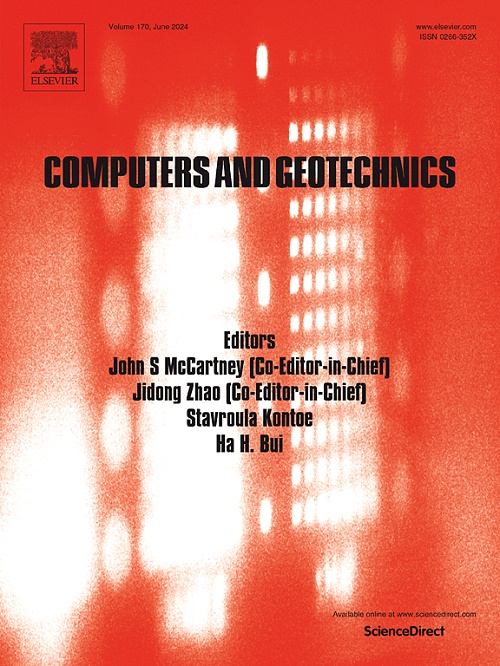面罩切屑与砂混合材料局部变形的微极次塑性模拟
IF 5.3
1区 工程技术
Q1 COMPUTER SCIENCE, INTERDISCIPLINARY APPLICATIONS
引用次数: 0
摘要
本文提出了一种新的基于微极的发育不良模型,以再现面罩片砂混合物(MSMs)的应力-应变关系及其局部变形。在临界状态发育不良模型的基础上,提出了一种非极性的mmsm发育不良模型,并对其进行了改进,提出了新的特征:(1)在柯西应力张量中引入附加应力张量,考虑了口罩芯片引起的内聚;(2)用修正的切向模量来描述MSMs的初始刚度变化;(3)引入有效骨架空隙率概念,捕捉msm的初始和临界空隙率变化。通过引入微极理论将模型扩展到微极项,该微极项包含了内部长度参数和粒子旋转引起的耦合应力,克服了传统有限元方法(FEM)模拟中的网格依赖问题。此外,还将新的微极发育不良配方实现为有限元程序。通过模拟一系列在纯砂和均质土上进行的双轴试验,研究了均质土剪切带的发生和演化过程。数值结果与实验结果进行了比较,表明所建立的微极发育不全模型能够很好地捕捉剪切带在msm中的传播及其力学响应。本文章由计算机程序翻译,如有差异,请以英文原文为准。
Micropolar hypoplasticity modeling of localized deformation in mixtures of face mask chips and sand
This paper presents a novel micropolar-based hypoplastic model to reproduce the stress–strain relationship of face mask chips-sand mixtures (MSMs) and their localized deformation. Based on a critical state hypoplastic model, a non-polar hypoplastic model for MSMs is first developed with modifications and new features: (1) the cohesion induced by face mask chips is considered by introducing an additional stress tensor into the Cauchy stress tensor; (2) the initial stiffness variation in MSMs is described with a modified tangential modulus; and (3) the effective skeleton void ratio concept is introduced to capture the initial and critical void ratio variations in MSMs. The model is then extended to its micropolar terms by incorporating the micropolar theory, which includes an internal length parameter and a couple stress induced by particle rotation, with the advantage of overcoming the mesh dependency problem in the conventional finite element method (FEM) based simulations. Moreover, the new micropolar hypoplastic formulations are implemented into a FEM code. The onset and evolution of shear bands in MSMs are investigated by simulating a series of biaxial tests on both pure sand and MSMs. Numerical results are also compared to experimental observations, demonstrating that the developed micropolar hypoplastic model can adeptly capture the shear band propagation in MSMs and their mechanical responses.
求助全文
通过发布文献求助,成功后即可免费获取论文全文。
去求助
来源期刊

Computers and Geotechnics
地学-地球科学综合
CiteScore
9.10
自引率
15.10%
发文量
438
审稿时长
45 days
期刊介绍:
The use of computers is firmly established in geotechnical engineering and continues to grow rapidly in both engineering practice and academe. The development of advanced numerical techniques and constitutive modeling, in conjunction with rapid developments in computer hardware, enables problems to be tackled that were unthinkable even a few years ago. Computers and Geotechnics provides an up-to-date reference for engineers and researchers engaged in computer aided analysis and research in geotechnical engineering. The journal is intended for an expeditious dissemination of advanced computer applications across a broad range of geotechnical topics. Contributions on advances in numerical algorithms, computer implementation of new constitutive models and probabilistic methods are especially encouraged.
 求助内容:
求助内容: 应助结果提醒方式:
应助结果提醒方式:


